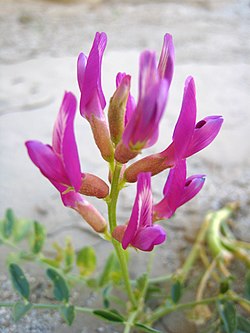| Astragalus | |
|---|---|
 | |
| A. lentiginosus | |
| Scientific classification | |
| Kingdom: | Plantae |
| Clade: | Tracheophytes |
| Clade: | Angiosperms |
| Clade: | Eudicots |
| Clade: | Rosids |
| Order: | Fabales |
| Family: | Fabaceae |
| Subfamily: | Faboideae |
| Clade: | Inverted repeat-lacking clade |
| Tribe: | Galegeae |
| Subtribe: | Astragalinae |
| Genus: | Astragalus L. |
| Type species | |
| Astragalus onobrychis [ disputed – discuss ] L. | |
| Species | |
Over 3,000 species, see list of Astragalus species | |
| Synonyms [1] | |
| |

Astragalus is a large genus of over 3,000 species [2] of herbs and small shrubs, belonging to the legume family Fabaceae and the subfamily Faboideae. It is the largest genus of plants in terms of described species. [3] [4] The genus is native to temperate regions of the Northern Hemisphere. Common names include milkvetch (most species), locoweed (in North America, some species) [5] and goat's-thorn (A. gummifer, A. tragacantha). Some pale-flowered vetches ( Vicia spp.) are similar in appearance, but they are more vine-like than Astragalus.



